Thrips and Pathogenic Plant Viruses
by Ann M. Mason, Fairfax Master Gardener
Adult thrips are very small, winged insects, less than 1/10th inch (2 mm) and smaller, in the botanical order Thysanoptera. Their small size helps them escape the gardener’s casual observation. Use of a hand lens or other magnification is needed to monitor plants. Unique to this arthropod bug is the name thrips that applies to one insect or to many.
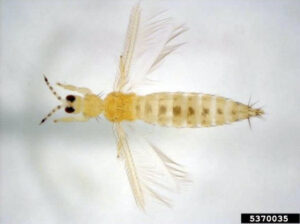
Western flower thrips, Frankliniella occidentalis, an example of a terebrantian thrip, one without a tube-shaped abdominal segment
Within the many genera in this order, a common feature of the more than 5,000 species that include both beneficial thrips that feed on other thrips and thrips considered pests, is their asymmetrical paired rasping-sucking mouthparts that they use to puncture leaf surfaces to suck plant juices — the characteristic of members of this order. The beneficial species feed on fungi, leaf litter, and small spiders, mites, whiteflies and other thrips. The pest species feed on the flowers and leaves of many commercially important crops including cotton, which are attacked by tobacco thrips (Frankliniella fusca) according to Virginia Tech scientists; peanuts (Arachis hypogaea); spring planted snap beans; tomatoes (Lycopersicon esculentum) and more. Crop scientists identified some thrips, mainly Frankliniella fusca, and the eastern flower thrip, F. tritici, and to a lesser extent the western flower thrip, F. occidentalis, as carriers of the tomato spotted wilt virus that is a commercially important pathogen decreasing production yield. Once the plant is infested with the virus there is no remedy or cure. Scientists report F. occidentalis is associated with dimpling on tomatoes.
Because of the plant damage they cause and the virus vectors (tospoviruses) they transmit, thrips are worthy of a gardener’s study and vigilant practice to monitor indoor and outdoor plants including newly purchased greenhouse plants. Using a magnifier, here’s what to look for:
Thrips have four fringed wings. Adult thrips are weak fliers but can ride the wind for dispersal and hitchhike a ride on plant materials.
Their mouthparts are asymmetrical. One mandible is shaped like a narrow stylet to drink plant sap; the other mandible is reduced or missing. Thrips rub the leaf surface to break it and then suck up the plant sap — a characteristic known as rasping-sucking. Some thrips inject digestive enzymes into the leaf that can carry plant viruses. Thrips feed on flowers, buds, leaves or fruit, depending on the species. This feeding causes distortion, discoloration and premature dying of the plant part attacked. Of note to the gardener: once you see damage, thrips causing the damage are gone.
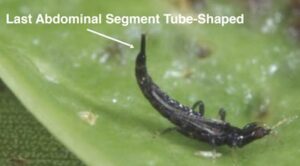
Cuban Laurel Thrips, Gynaikothrips ficorum, an example of tubuliferan thrips with the last abdominal segment shape in a tube
Adult thrips have three body parts: head, thorax and abdomen. To identify thrips into botanical families, entomologists look to the last part of the abdomen to distinguish thrips into two broad categories: thrips with tube-shaped last abdominal segment [tubuliferan, also known as exotic thrips and those that do not have a tube-shaped segment [terebrantian, native thrips].
Some thrips observed in Virginia, specifically the tobacco thrips, western flower thrips, and eastern flower thrips, all in the genus Frankliniella, do not have a tube-shaped segment and fall into the terebrantian category. An identifying characteristic of Frankliniella thrips is the presence of well-developed hairs on the anterior part of the thorax as shown in the top image above.
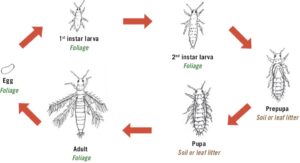
Life Cycle of Western Flower Thrips
Thrips reproduce fast. They undergo a simple hemimetabolous reproductive process meaning that there is a three-stage life cycle where the thrips increase size while maintaining the same basic characteristics at each stage. Female thrips can produce eggs either by mating or not mating (parthenogenesis). Researchers report that non-mated females lay eggs that result in male thrips; fertilized eggs produce female offspring.
Female thrips in the tubuliferan grouping plant their eggs on the surface of the leaf; terebrantian females use their saw-like ovipositor (last abdominal segment) to slit the leaf to deposit eggs within the leaf tissue. After hatching, the larval thrips pass through two larval stages and undergo two pupal stages (terebrantian) or three pupal stages (tubuliferan). Adults emerge and start to feed and lay eggs. The timing of the life cycle depends on the species but generally is completed within two weeks under favorable conditions. Reproduction peaks in spring and summer and many generations occur in a year. Thrips overwinter as adults or immature larvae in plant debris.

Predatory minute pirate bug
Nature provides biological controls but often the thrip’s rapid reproduction rate outpaces these predatory insects. Predators with a taste for thrips include green lacewings, minute pirate bugs, some mites, predatory thrips and certain parasitic wasps. Gardeners can attract nature’s predators by planting host plants for these predators; control weeds that attract thrips; use cultural practices (watering, planting in appropriate light and soil) to keep plants healthy and unstressed; avoid use of high nitrogen fertilizers; and plant thrip resistant plants.
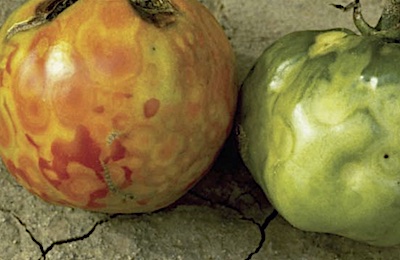
Thrips cause tomato spotted wilt virus on tomatoes
Gardeners can make plants less attractive to thrips by pruning and removing injured and diseased terminal leaves from landscape plants; proper pruning just above branch crotch or nodes rather than shearing; using fine mesh row covers over newly planted and young crops; and water plants at the root line using drip irrigation or other means to avoid wetting leaves. Virginia Tech reports that common host plants for thrips in Virginia include onion, beans, beet, carrot, cabbage, cauliflower, celery, cucumber, melon, peas, squash, tomato and turnip. For thrip control on houseplants Virginia Tech recommends washing thrips off the plant with warm or tepid water containing insecticidal soap particularly where leaves join branches and at the base or crown of the plant — locations where insect pests like to hide.
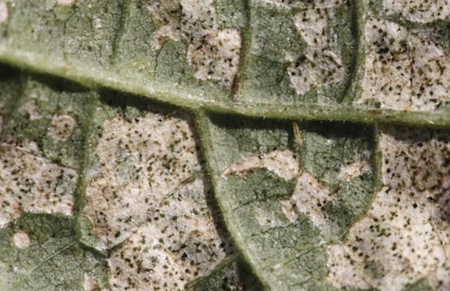
Western flower thrips damage
Scientists report that no chemical control will restore unsightly leaf and fruit damage caused by thrips because the damage is already done. Thrips are difficult to control with insecticides because of their mobility and protective coverings during egg and pupal stages. Gardeners wanting to use chemical treatments should consult with VCE experts or plant specialists at garden centers who can guide their choices. Any application of a chemical should include a thorough reading of the safety label since some chemicals will adversely impact pollinators and beneficial predator allies in waging the battle against thrips.
Resources
• Thrips in Greenhouses, Virginia Cooperative Extension, Publication 444-281 (ENTO-373NP)
• Pest Thrips of the United States: Field Identification Guide, USDA-CSREES Integrated Pest
Management Centers, National Plant Diagnostic Network, APHIS and others.
• Thrips, Pests in the Gardens and Landscapes, University of California Integrated Pest Management
• Onion Thrips, Virginia Cooperative Extension, Publication 3104-1556
• Western flower thrips, Virginia Tech